The ability to recall specific brands is often due to their memorable visual elements, like their logo and color scheme. So, in order to reach your target audience and capture their attention, your company needs to convey your values, products, and objectives through your appearance.
If you haven’t paid much attention to this aspect of your marketing, it might be time to ask your team some brand identity questions. This will help focus your efforts and make them cohesive and memorable. Or maybe you have invested a lot of time and resources into creating your brand identity, but it’s not as effective as you would have hoped. Maybe it feels outdated or irrelevant. Ask your team these questions to get back on track.
Let’s cover the basics.
What is a Brand Identity?
Brand identity refers to the visual elements of a business. This includes:
- Brand name: The name by which a brand is known and recognized.
- Logo: A unique and visually appealing symbol or design that represents the brand. The logo often incorporates elements such as colors, typography, and imagery that convey the brand’s values and personality.
- Tagline: A short, memorable phrase or slogan that captures the essence of the brand and its positioning.
- Colors: Specific color palettes that are consistently used across various brand elements. These can evoke emotions and contribute to brand recognition. Think the iconic red of Coca-Cola or the simple Black of Nike.
- Typography: The choice of fonts and typographic styles that are used consistently in brand communications. Typography can convey different tones and personalities.
- Visual elements: This includes imagery, icons, patterns, and other visual aspects that are associated with the brand and contribute to its visual identity.
- Tone of voice: The style and manner of communication used by the brand, including the language, vocabulary, and overall writing style. The tone of voice should align with the brand’s personality and target audience.
- Brand values and messaging: The core values, mission, and vision of the brand, as well as the messages and narratives it uses to communicate with its audience.
When these elements are combined and consistently applied across various brand touchpoints, they create a strong image that helps consumers recognize, remember, and form associations with the business.
This is one of the first things potential customers will notice and make a decision based on. Every industry is saturated with competition, and people haven’t got the time to research the best business for them. For this reason, your visual elements need to help customers make quick decisions and opt for your product.
3 Essential Brand Identity Questions
It’s becoming clear that forming a solid brand identity is essential for companies, not only to generate leads and encourage conversions but also to nurture customer loyalty. So where do you start?
Figuring out your company’s brand story should kickstart your strategy. To do this, you’ll need to ask your business a set of questions that you have compiled to determine your brand message. By answering these as a team, you’ll begin to understand how to form your identity. Without further ado, let’s look at the best questions to ask.
1. What Is Your Unique Value Proposition?
This is a statement that clearly defines what your company can offer customers. It needs to clarify how your value is unique and not replicated by your competitors. In other words, what sets you apart?
Once your business understands this clearly, and you’ve got a well-written statement to help remind your team, you will be able to form a marketing strategy that conveys your message. This UVP will be at the heart of your identity, so it will help inform your logo, name, color scheme, and more.
For example, if your UVP is your commitment to sustainability and environmental consideration, then it’s likely your logo will incorporate this. This means you’ll probably opt for natural colors like greens, blues, and browns in your marketing materials.
2. What is Your Brand’s Personality?
This is a key question when it comes to content marketing because it will determine how your brand is perceived and how you communicate and interact with your customers. There are five main types of personality:
- Ruggedness
- Sincerity
- Competence
- Sophistication
- Excitement
Below, you can see a breakdown of the common traits associated with each of these personalities. Once you have decided which one suits your brand story the best and reflects your ideal customer, you will know the brand voice you should use and what kind of presence on social media is best.
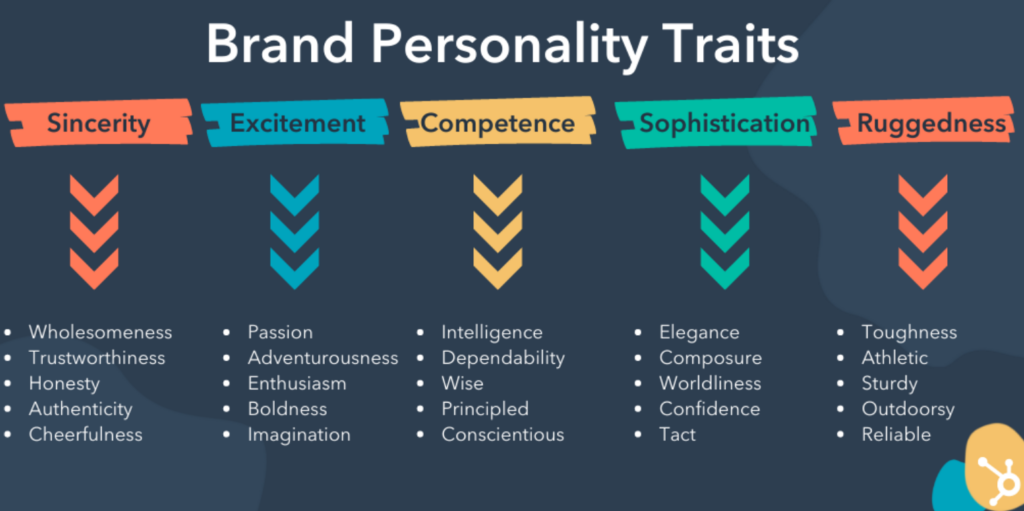
3. Can You Picture Your Ideal Customer?
All elements of your branding should be based on attracting your ideal customer. How can you do that if you’re not sure who it is? The following questions will help visualize your audience:
- What age is your audience?
- What is their average income?
- What do they do in their spare time?
- Do they have families?
- What careers are they likely to have?
- What gender do they identify as?
- Where are they likely to live?
Brand Image vs Brand Identity
They say not to worry about what others think of you, which is great advice in person. Unfortunately, this couldn’t be further from the truth when it comes to branding. Frankly, your success rides on the perception of others.
Once a negative reputation has taken off, it’s hard to prove your worth again, even if you have strong values and a stellar origin story.
But all is not lost. This is where brand image and identity come into play – no, they’re not the same thing!
If you believe in your brand, half the battle is getting others to believe in it too. By fostering a positive image, you can let your identity shine through which will lead you to long-term success with loyal followers.
To get a full run-down on branding and how image and identity differ, read on. Once you understand how to utilize both, your brand will be a household name before you can say, ‘Best company ever!’
What is Brand Image?
A company’s brand image is all about how customers, stakeholders, and potential employees perceive you from the outside.
As you can imagine, a lot is riding on having a good brand image, so it requires plenty of research, time, and introspection to get it right. You can claim to be whatever you want, but if it’s not reflected in your products, services, or overall business practice, your brand image is left in the hands of the collective. Too many false promises, and you’ll find your customer base turning into judge, jury, and executioner.
For example, if you sell strawberries and claim them to be the best in the country (with a catchy slogan and logo to boot), you’ve got to have the tools to back up your claim. The brand image you created in the conference room only goes so far if your strawberries are consistently moldy and delivered behind schedule.
Soon, word will catch on, and existing customers will tell others how disappointed they were with your service. This results in a negative brand image and a fall in revenue – among many other negative consequences.
Multiple elements go into a brand image that tends to be outside the company’s influence. Let’s look at some of them together.
Brand Awareness
Awareness of a brand is more than just knowing it exists. Brand awareness is when a customer can recall a brand and what it stands for. The more widespread it is, the better.
The ultimate goal of brand awareness is to embed itself within a customer’s lifestyle; for example, using Amazon to order products online or using Starbucks to get their morning coffee before work. There’s no second-guessing because there is already an underlying association between the company and its product or service.
Achieving brand awareness builds trust and loyalty with customers in several ways:
- Social proof: The proof that your company is the best is in the social pudding. The more others hear about positive customer experiences with a company via word-of-mouth, the more trust you will build with them. This can be heard from close friends, family, and even influencers online.
- Familiarity: There is a trick of the trade where the more a brand pops up in marketing channels like social media and advertising, the more familiarity and brand recognition are fostered. Humans are hardwired to prefer what is familiar to them as it is deemed safe and reliable.
- Authority: Customers don’t necessarily want to be told what to do or think, but a brand that is an expert in the field demonstrates authority over the competition. If they are the loudest (and most competent) voice in the crowd, it’s no wonder heads turn to listen.
Brand Experience
From the moment someone hears about a brand, the experience begins. This is the first touchpoint when customers interact with a brand throughout their journey. These moments are where the magic happens, so optimizing each one to create a positive experience is essential.
Creating an excellent experience at each touchpoint will create a strong brand image overall. The idea behind it relates back to social proof: when the majority of people enjoy their customer journey, others will want to join in.
Brand Reputation
This brings us to brand reputation, which takes lots of time and effort to build, but only takes moments to come crashing down. When things go really wrong, it can even cost a company 10% more in wages.
As we are in the digital age, where every single thought and experience is shared with the masses, it doesn’t take long for word to get around if a brand lets multiple customers down with poor products, experiences, or affiliations.
However, such widespread buzz can also work in your favor if your brand constantly goes above and beyond. Now target audiences from all corners of the internet can hear about it and check you out for themselves.
Your brand reputation relies on what others think of you, and as with all elements of a brand image, there is little you can do to control it once the ball starts rolling. In worst-case scenarios, a company can rebrand itself as a fresh start if it knows what not to do next time.
How Are They Different?
Okay, now that we’ve delved into both brand image and brand identity, it should be clearer as to where they differ.
To explain it simply, a brand image is the perceptions and feelings of external groups about a brand, including customers, potential employees, and stakeholders. It is based on experience, touchpoints, and overall reputation. A brand’s image is the first thing that pops into someone’s head when they hear their name or see their logo.
On the other hand, brand identity is the way in which a company portrays itself through visual elements, messaging, and values. It runs deep into why the brand was created in the first place. Identity is important for standing out in the market, attracting those who share similar values, and creating a long-term roadmap.
So, if you’re a business owner launching a new brand, image and identity will play a huge part in your success. Remember, you can’t have one without the other.
Top 3 Brand Identity Worksheets
Crafting a strong brand is crucial in today’s competitive landscape. It allows you to stand out from your rivals and capture the attention of your target audience. However, creating a truly innovative and appealing brand is no easy feat, involving many hours of careful deliberation over the finest details.
Thankfully, there are a multitude of incredibly helpful worksheets to guide you through this strenuous process. Join Literal Humans as we explore the best worksheets available, offering detailed frameworks, exercises, and questions to uncover your brand persona.
The Top 3 Worksheets To Design A Strong Brand
There are countless high-quality brand identity worksheets available on the web. Today, we have selected three that are sure to provide you with a clear brand strategy going forward.
1. The Futur
This remarkable free download is the perfect document to help entrepreneurs discover their overall brand strategy. Their website claims they are the ideal document if you are:
- Struggling to find your brand identity
- Unsure how to explain your company’s purpose
- Publishing content but not seeing the desired results
- Finding it hard to narrow down your business’s niche
The sheet is divided into four distinct sections, which can be seen in the table below.
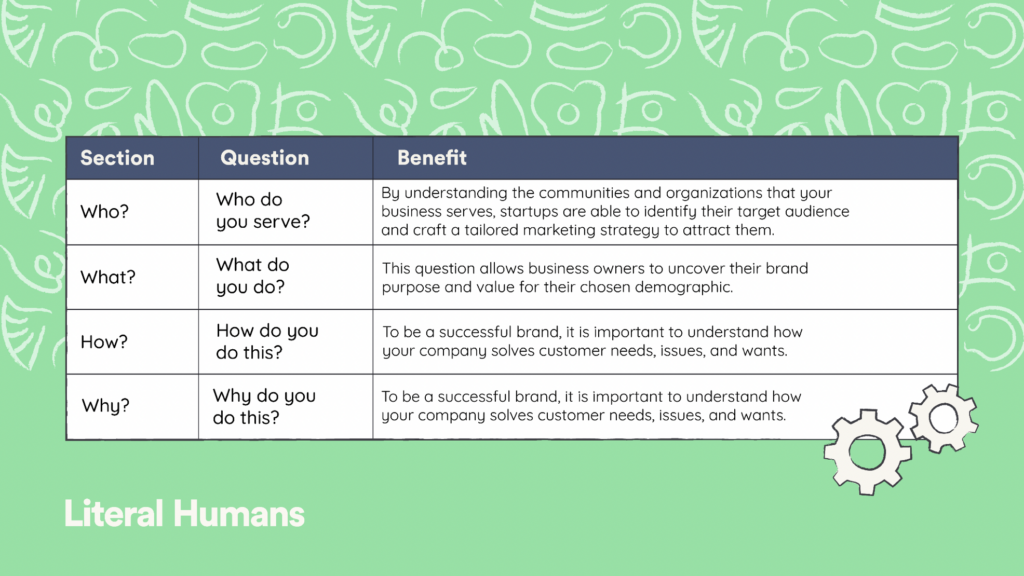
The final section of this worksheet is called ‘pull it all together’. It tasks business owners to summarize these points into a concise positioning statement using the following template.
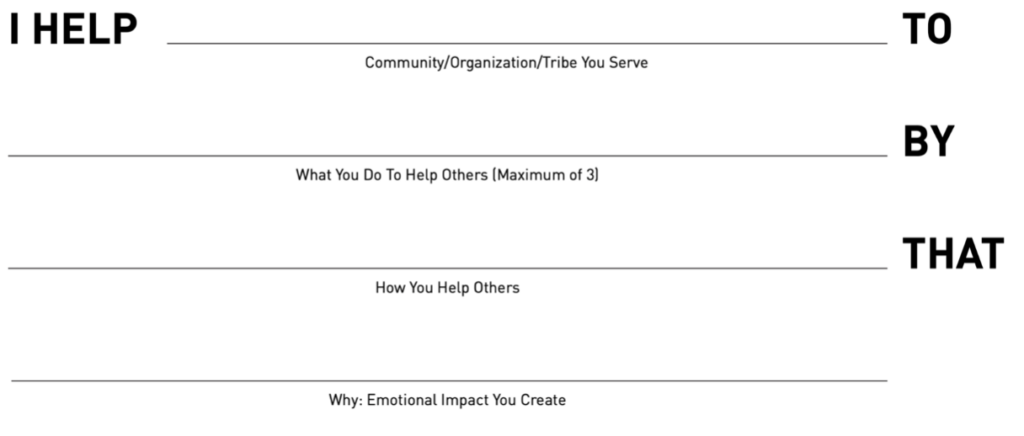
The website provides the following illustrative example to show how to fill out this particular form.
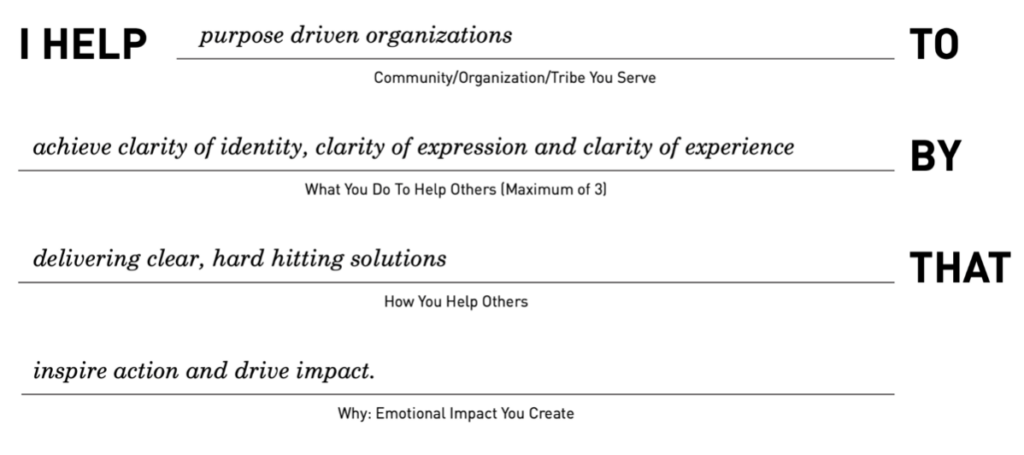
2. Techstars
Techstars acknowledges that crafting a solid brand strategy is the key to:
- Creating brand awareness amongst your target market
- Increasing overall sales and conversions
- Growing your business
To achieve this feat, the company offers an online workbook that is sure to help you define your brand personality.
There are multiple exercises within this workbook that act as important tools to craft a strong brand persona.
The first exercise tasks business owners to select ten different products and describe their emotional connection with them. It then asks individuals to repeat the process for their own product, considering what emotions and benefits they want their consumers to feel.
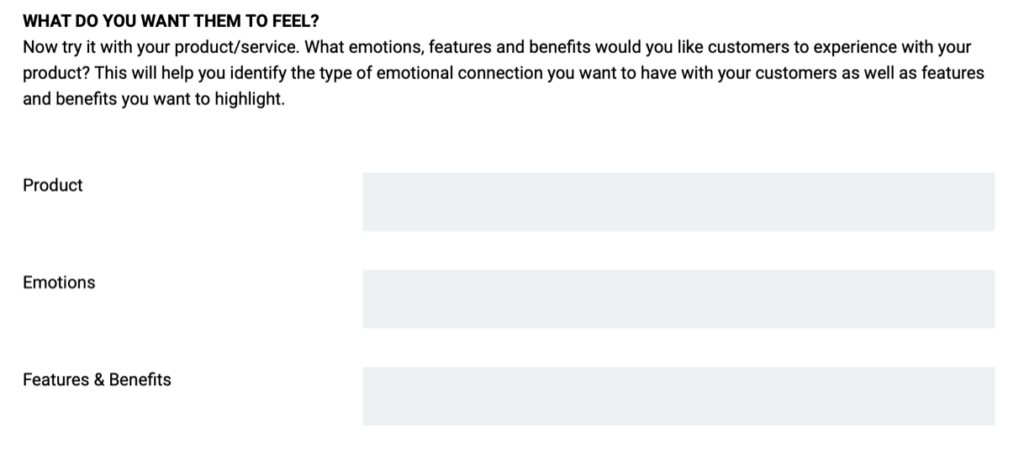
However, the main focus of this worksheet is to create a brand identity map – a diagram that outlines the ins and outs of your business. The team provides the following tips before starting this task:
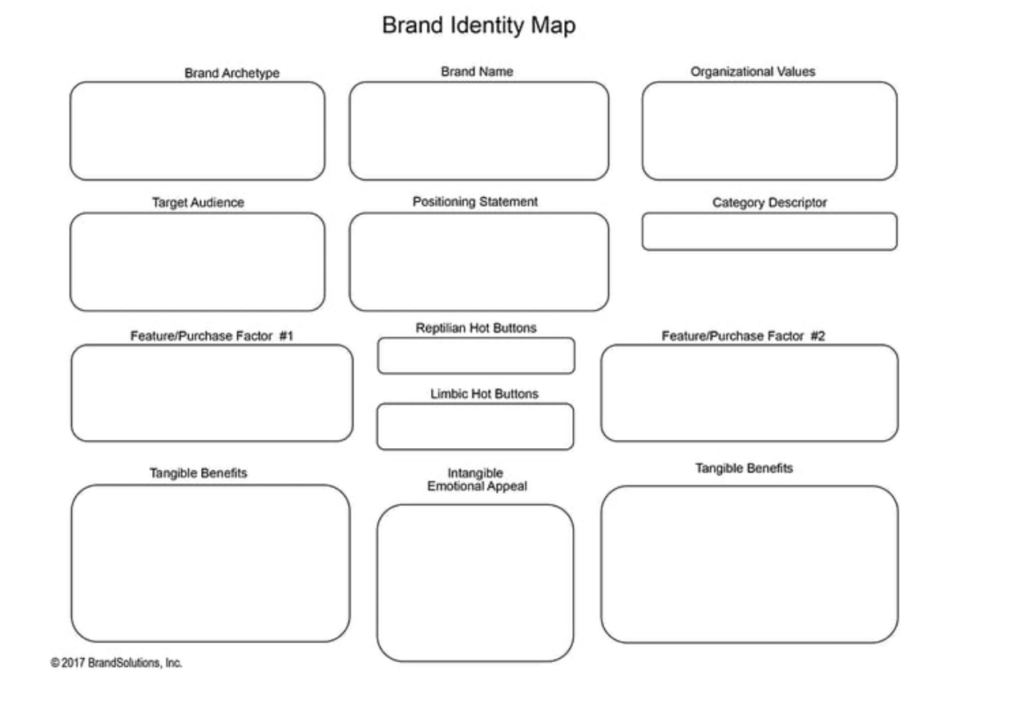
- Ensure there is a diverse selection of team members, including the founders of the company
- Make sure that the whole team agrees on the central message
- Leadership must believe in the message and utilize it in every aspect of the company
Techstar includes a template that teams can use to complete this task.
The brand identity map is split into numerous categories featuring multiple questions, which can be viewed in the table below.
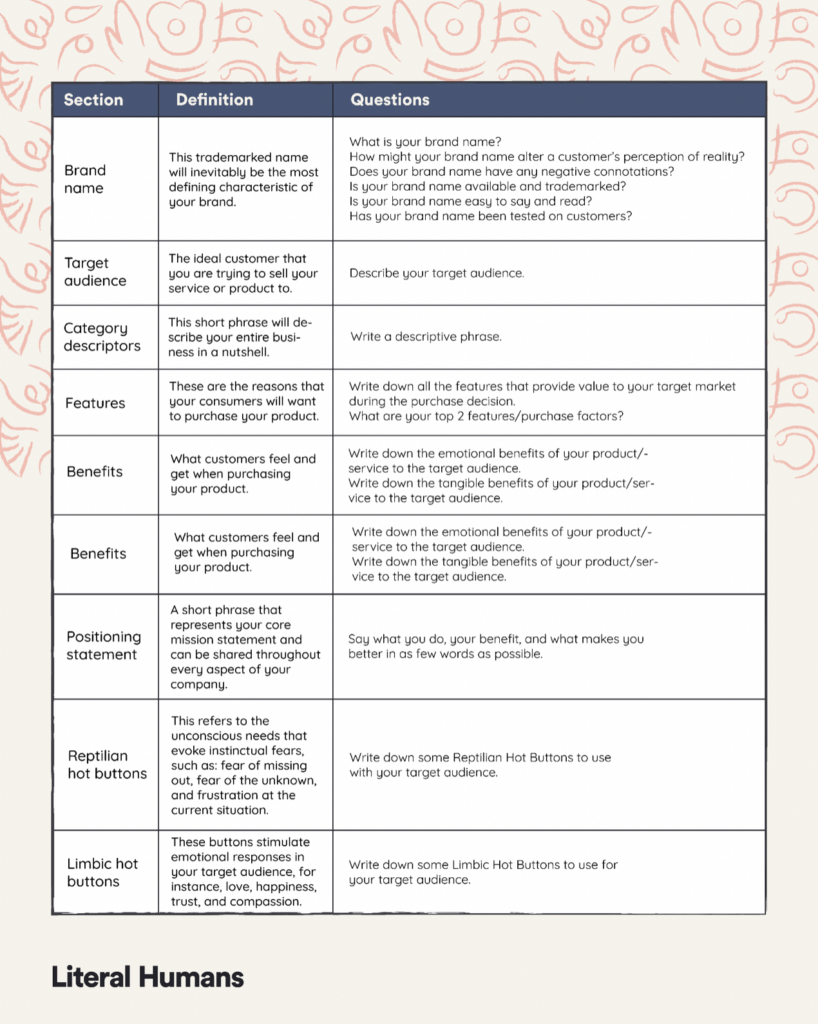
Once all of these stages are completed, your brand identity map should resemble the following example:
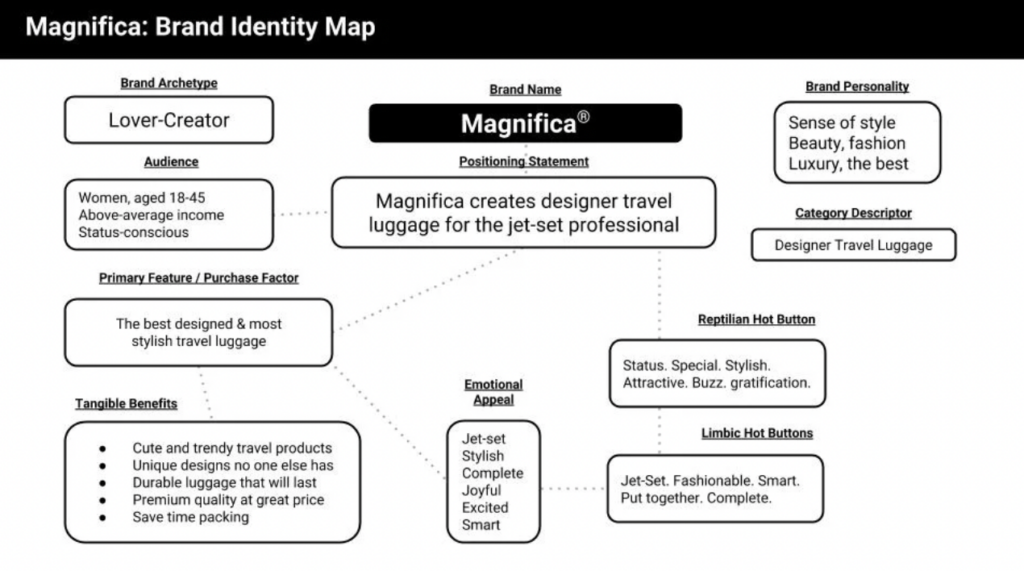
3. Good Egg Marketing
Good Egg Marketing has created this online worksheet that helps business owners design a distinctive visual identity. The company recommends that you hand this finished document to your graphic designer to aid them in creating a captivating logo design, color palette, and fonts.
It is important to note that this branding must remain consistent throughout every aspect of your business, including:
- Signage
- Website
- Typography
- Business cards
- Promotional material
- Social media
- Emails
- User interface
- Work culture
- Employee outfits
- Customer service
The worksheet is divided into numerous different sections that help entrepreneurs explore the ins and outs of their brand identity, including:
- Your identity: This section asks you to look at your core values and business goals to truly understand what your business stands for.
- Your business: Here you will cover your business basics, including location, industry, purpose, selling platform, and how this will inevitably affect your branding.
- Your niche: It is time to explore your niche and take a look at your demographic, their needs, and how you remain in contact with them.
- Your competitors: By listing 3-5 competitors, you can understand similarities, differences, and your unique selling points.
- Brand personality: Now it is time to get creative by selecting 3-5 adjectives describing your business as a person.
- Descriptor: This section asks business owners to create a 3-8 word description of who they are and what they do. While this shorthand version works fantastically as an alternative to a tagline, it is recommended to expand this descriptor to 25-100 words to be used in marketing, social media, or your website.
Tagline: Come together to create a catchy phrase that encapsulates your entire business philosophy in a nutshell.
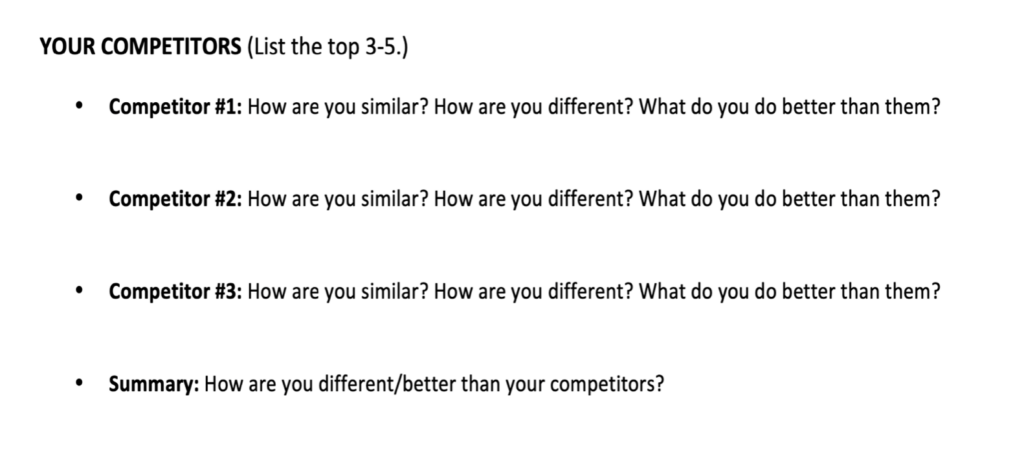
Launching Your New Brand Identity
While we have highlighted three fantastic brand identity worksheets, it is important to note that there are many more options available online that offer countless other activities and tasks.
Now you have finished exploring your brand, it’s time to implement your new strategy across your entire business. Make sure the results of your branding brainstorm can be felt in every inch of your company, from your work culture to your marketing.
So, what are you waiting for? Find the perfect worksheet online now, gather the entire team, and together start dreaming up your ideal brand.










